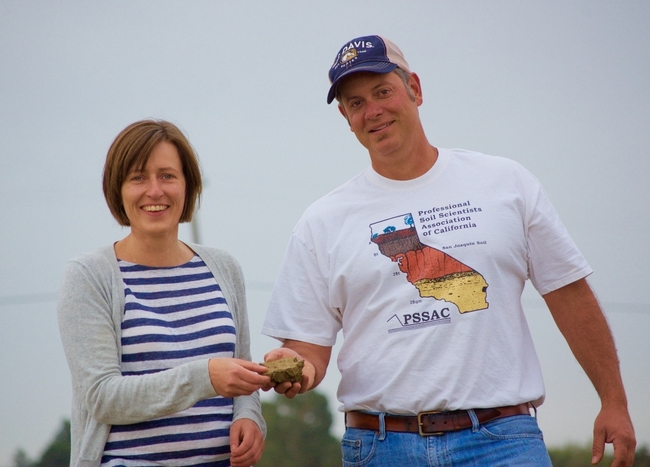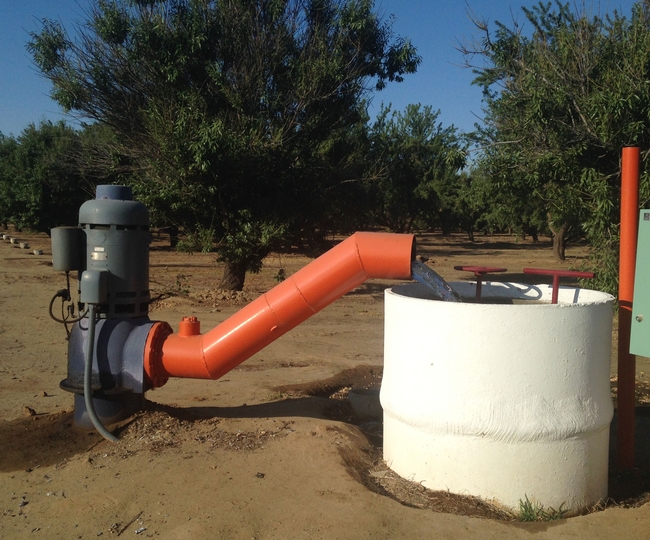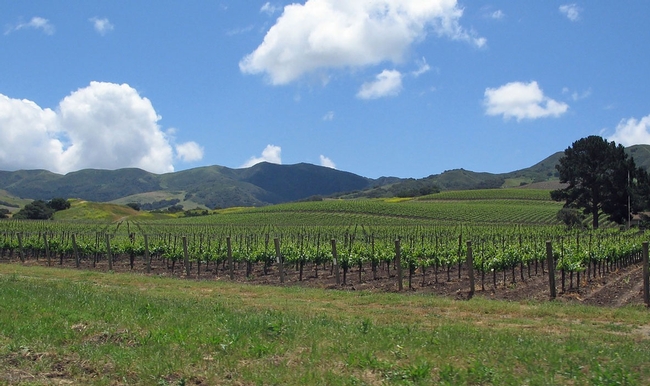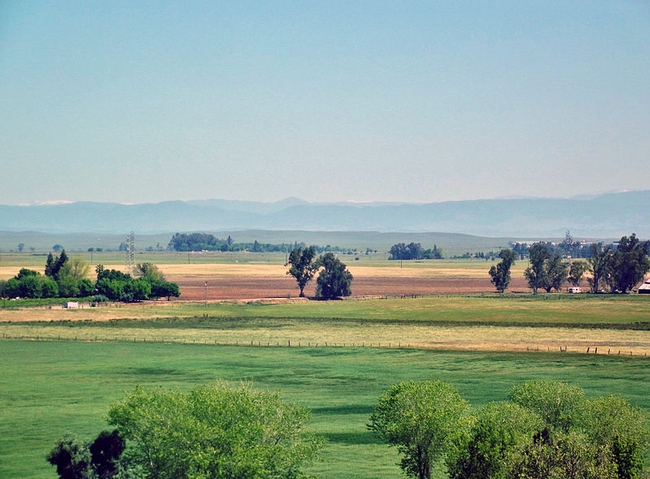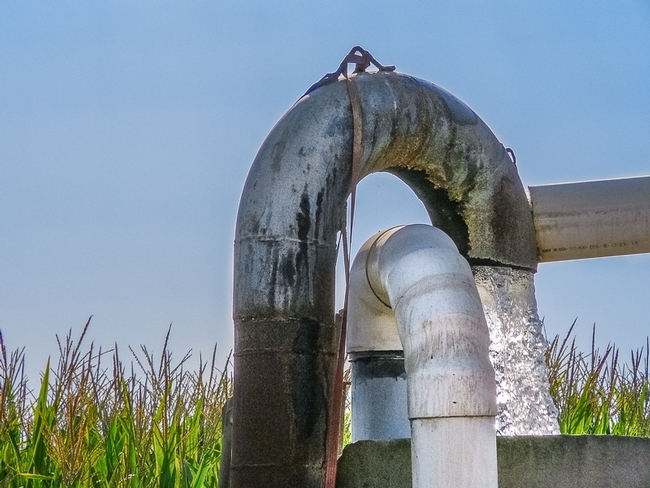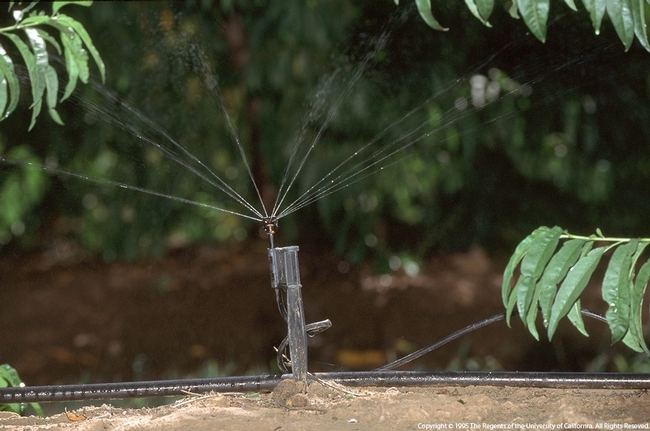Posts Tagged: groundwater
Groundwater banking captures the media's imagination
With rain falling, interest in UC Agriculture and Natural Resources (UC ANR) research on groundwater banking has been high. In California Agriculture journal, UC ANR Cooperative Extension specialist Toby O'Geen and 13 co-authors shared research on California soils that showed which areas in the state were best suited for water to be percolated down into an aquifer.
The article included a map of California with color coded areas indicating areas that were excellent for groundwater banking down to poor. The story was picked up widely by the news media.
California farmers will intentionally flood their fields this winter
Jane Braxton Little, Scientific American
For two months this winter, a team of scientists will flood almond orchards in the Central Valley to a depth of two feet by redirecting rainfall through a network of ditches originally designed to divert floodwater away. To measure success, they will then monitor how much water filters into the water table over the course of two years. If the method pans out, pear, plum and walnut tree orchards might also benefit from intentional flooding, according to a recent study led by UC ANR Cooperative Extension specialist Anthony O'Geen.
Map identifies farmland with greatest potential for groundwater recharge
Diane Nelson, UC Davis News Service
This December, O'Geen and a team of scientists - including Helen Dahlke, professor in integrated hydrologic sciences at UC Davis - will flood almond fields in the Central Valley, building on research that suggests that deliberately flooding farmland in winter can replenish aquifers without harming crops or drinking water. “Adding an extra few feet of water to even just 10 percent of California's cropland this winter could add an additional 3 million acre-feet of groundwater,” Dahlke said. “That could go a long way toward replenishing the 6 million acre-feet growers had to pump this year alone to cope with California's drought.”
UC scientists test inexpensive way to capture El Niño rains
Amy Graff, The San Francisco Chronicle (SFGate.com)
Researchers from UC Davis and UC Cooperative Extension are testing a new method for capturing some of that underutilized water by diverting it from rivers into the network of canals running through Central Valley farmland. "That could go a long way toward replenishing the 6 million acre-feet growers had to pump this year alone to cope with California's drought," said Dahlke, who's testing the technique in the field. UC ANR Cooperative Extension specialist O'Geen points out that this is a win-win for agriculture. "They're typically considered the bad guys. They're feeding the world yet they're considered the water hogs because they have to take all the water to grow the food. On-farm recharge offers the opportunity for them to offer two services — providing food and collecting water. That puts agriculture in a better light."
How California could get smarter about droughts and flooding
Nathaneal Johnson, Grist.org
Land suitable for flooding should be flat, free of contamination and clear of structures. O'Geen estimates that leaves 3.6 million acres. “A preliminary calculation based only on soil properties and crop type shows that landscapes rated Excellent or Good could be used to bank as much as 1.2 million acre feet of water per day.” UC ANR groundwater hydrologist Thomas Harter was also a source in the article. He said there are additional challenges to overcome, including reluctant farmers, variations in soil profile, red tape and a lack of infrastructure, especially on farms that now use micro sprinklers or drip irrigation systems, rather than flood.
California farmers hope to capture El Niño rains
David Dienick, KCRA 3 News
Researchers have been looking for ways to capture more runoff without relying on reservoirs. "We've never actually managed our agriculture landscapes for groundwater recharge to my knowledge," O'Geen said.
Farmers urged to flood their fields with any upcoming rain
KFBK News Radio
A soil map has been developed that will allow farmers to take advantage of every opportunity to recharge the groundwater. "Is it a managed event where we are giving a couple extra irrigations in the winter time and the wet crops can tolerate a few extra irrigations when they don't really use the water," O'Geen said.
Another study suggests flooding farmland to recharge aquifers
Tim Hearden, Capital Press
A study in Merced, Madera and Fresno counties will determine whether diverting excess river flows from winter storms to farmland successfully. In addition, O'Geen and Dahlke plan to use some of the state's 3.6 million acres of farms and ranches with suitable topography and soil conditions to recharge aquifers during winter months. Dahlke is still conducting field experiments to evaluate how much water can be recharged in a couple of weeks.
UC maps farmland that can 'bank' groundwater during El Niño rains
KPCC 89.3
In response to California's withering drought and a dwindling water supply, researchers at UC Davis have identified farmland that could potentially "bank" groundwater during what is predicted to be an unusually wet winter. "A lot of growers are interested in learning how they can help improve the groundwater situation in California," O'Geen said. "The index provides details on the groundwater-recharge potential for any parcel, which you can search for by address or access using your device's GPS."
California water is not 'liquid'
California growers are plumbing the depths beneath their farms to retrieve groundwater for thirsty crops, an example of the tragedy of the commons, reported Peter Coy in Bloomberg Businessweek.
One reason: California water is not liquid, financially speaking, said a UC Agriculture and Natural Resources expert. California's mechanism for trading water is slow, clunky, and opaque.
“If you wanted to do a trade now, you'd have to meet a broker in a coffee shop somewhere. There's no Wall Street Journal, no Bloomberg, no Carfax,” said Richard Howitt, a professor in the Department of Agriculture and Resource Economics at UC Davis.
California has a system for regulating surface water. A law regulating groundwater passed last year, but it will be enacted in stages and doesn't fully phase in until 2040, the Bloomberg story said. A fully liquid water system would send more water to urban areas and continue the shift in agriculture to more high-value crops, such as grapes, tree nuts and fruit and tomatoes.
The article suggests that Californians can learn from Australia, where water rights are traded on an exchange like stocks, prices are posted for all to see, and transactions can be concluded in a day. Allocations are based mainly on a share of what's actually available, not unrealistic fixed amounts.
“America is the home of free enterprise,” said University of Adelaide professor Mike Young. “The fact that there's not a water market in America means the institutional arrangements are all wrong.”
Many landowners believe they own underlying groundwater
Wee sought comment from UC Agriculture and Natural Resources groundwater hydrologist Thomas Harter, a Cooperative Extension specialist based at UC Davis.
"The mentality among landowners is, 'This is really my water,'" Harter said. "'It's part of my property and I don't want anybody to look over my shoulder.'"
Farmers typically use groundwater as a water savings account to draw upon when surface water is unavailable for irrigation. However, after four years of drought and dramatic cuts in surface water allocations, those with more money are drilling deeper wells, often leaving shallower wells high and dry. Removal of the undergound water is also causing land subsidence.
"There are large parts of the southern Central Valley that last year alone have sunk between six inches and a foot," Harter said.
The CNBC report said a recent update on California's drought had gaps in groundwater monitoring. Among the reasons for the data gap: Reluctance of private well owners to grant permission to monitoring entities. Other well owners were hesitant to release well construction details.
Harter said he believes compliance with new groundwater regulations will be challenging.
"People are used to turning on their faucets without thinking about how much they're using," Harter said. "It's a painful process."
Groundwater records should be public, says UC ANR expert
Harter, a UC ANR specialist based at UC Davis, and co-author Laurel Firestone, shared their thoughts in an op-ed penned for The Guardian. Firestone is co-executive director of the Community Water Center in California, which helps disadvantaged communities gain access to clean, affordable water.
The authors wrote that state records with information needed to characterize groundwater aquifers are kept confidential under a 64-year-old law that considers them proprietary to well drillers. The well logs contain data that is public in every other state in the West and include details such as where wells are located, their depth, potential pumping rates, diameter and descriptions of the sediments and rocks the wells go through.
"The lack of information is a major impediment to stewardship of the resource," the op-ed says.
California State Senator Fran Pavley introduced Senate Bill 20 in December, which if passed will make well log data publicly available in California.
"Perhaps as more community and farm wells dry up this summer, the legislature will extend its enthusiasm for transparency to the critical information needed for more equitable and sustainable management of our groundwater," Garter and Firestone conclude.
Replenishing California groundwater
For more than a century, California farmers have extracted water from underground to irrigate crops during droughts or where surface water is not available. However, in recent decades, water reservoirs that accumulated over thousands of years underneath the state's valleys are being tapped with deeper and deeper wells that pull out more water than can be replenished in the winter.
The 2012-14 drought intensified the problem. Greater groundwater usage than recharge has left some rural homeowners' wells completely dry. Land is subsiding as clay layers that are interspersed between sandy and gravelly aquifers beneath the surface compress due to lower pore water pressure, which is responsible for keeping clay pores open.
To ensure California's aquifers are available to meet future generations' water needs, proper management in terms of extraction and replenishment is critical, says Thomas Harter, UC Cooperative Extension groundwater hydrology specialist.
Urbanization and advances in agricultural technology have reduced historic groundwater replenishment. Asphalt, concrete and buildings block water infiltration. Water-saving irrigation devices – like drip and microsprinklers – are more protective of groundwater quality, but have reduced the amount of water applied to crops and are cutting down on recharge into the aquifer.
In urban areas, substituting gravel for concrete and leaving areas undeveloped can boost aquifer levels. There is also more that can be done in the agricultural sector to replenish groundwater with clean recharge.
“This will not happen overnight,” Harter said. “But in the intermediate term, it is important to understand how we can use the agricultural landscape to apply additional clean water to recharge the aquifer.”
The project is led by Helen Dahlke, assistant professor in integrated hydrologic sciences at UC Davis and faculty member with the UC Division of Agriculture and Natural Resources Agricultural Experiment Station (AES). The team includes UCCE specialists Harter, Daniele Zaccaria and Samuel Sandoval Solis, AES faculty member Dan Putnam, and UCCE advisors Allan Fulton (Tehama, Colusa, Glenn and Shasta counties) and Steven Orloff (Siskiyou County).
The scientists hypothesize that alfalfa fields and irrigated pastures might be ideal locations for clean aquifer recharge. Both crops demand a relatively low use of fertilizers and pesticides, which means the water soaked down from these fields will be unlikely to carry large amounts of contaminants to the aquifer. The prevalence of flood irrigation in these systems might provide the infrastructure needed to convey surface water, reducing the potential cost of implementing new flood flow capture systems.
The idea is that during storms (or flood control releases) excess surface water could be directed from streams via existing water conveyance systems onto dormant agricultural fields, which would serve as infiltration basins. If successful, tens of thousands acre-feet of water could be recharged annually into California's aquifers during very short periods.
“The banked groundwater would then be available to farmers and municipalities to draw on during dry years,” Harter said.
The project will provide data to address concerns about the costs and risks to crops, the influence these projects may have on groundwater levels and flows, and the possibility of recharging contaminated water or degrading groundwater quality by leaching contaminants such as nitrate into the aquifer.
For more information on groundwater replenishment, see Out of sight but not out of mind: California refocuses on groundwater in the July-September 2014 issue of California Agriculture journal.
An initiative to improve California water quality, quantity and security is part of the UC Division of Agriculture and Natural Resources Strategic Vision 2025.


